Last Updated on September 9, 2023 by a Friendly Gardener
Pothos plants, regardless of the variety, regularly have their praises sung, and rightly so. Pothos plants are notoriously undemanding making them perfect for beginner indoor gardeners and for houseplant aficionados that have limited time to dedicate to plant care. But is Silvery Ann a genuine pothos?
Foliage features a glorious green matte background with silvery splashes. Botanically known as the Scindapsus pictus ‘Silvery Ann’, it may be found under the common names of the Pothos Silvery Ann, the Silver Pothos, and the Satin Pothos. Belonging to the Araceae family, this beautiful plant is an aroid and not truly a pothos as it does not belong to the Epipremnum genus, but to the Scindapsus genus. While it may feature characteristics common to other varieties, variegation is more disorderly and contains more silver.
The Silvery Ann finds its native habitat in Southeast Asia and can be cultivated outdoors in USDA hardiness zones 9 through 11. Its trailing growth habit allows it to spread as much as ten feet and grow to heights of just past three feet. Its lush, variegated foliage makes it a highly desirable houseplant although it is not known to flower when cultivated indoors. This plant produces no discernable fragrance.
Silvery Ann Pothos Plant Care
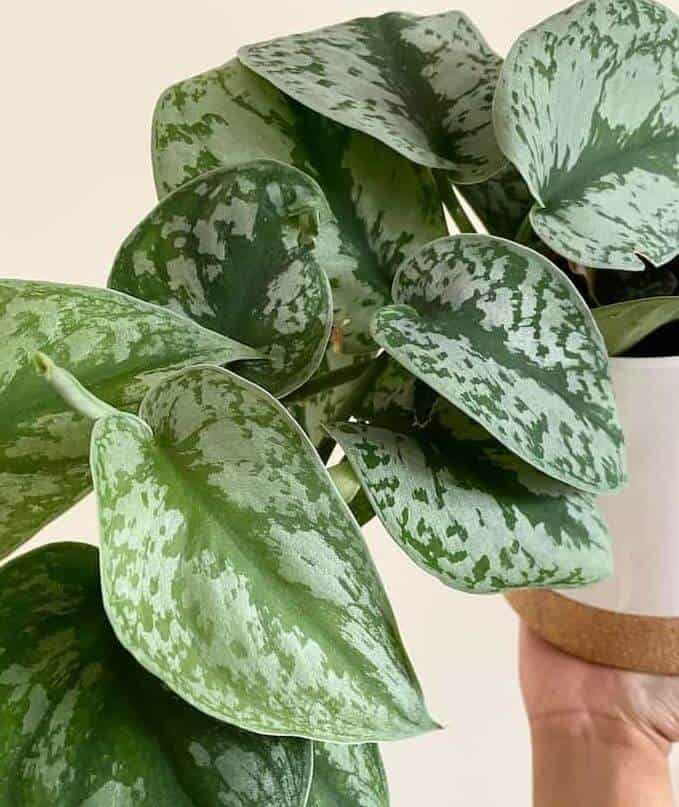
The pothos Silvery Ann, just like true pothos varieties does not require much care. It’s beautiful and low maintenance!
Soil
Any quality potting mix will do fine when cultivating this houseplant as long as it is well draining with some degree of moisture retention. The Scindapsus pictus ‘Silvery Ann’ likes the soil pH to be a little acidic measuring between 6.1 and 6.5. To mix a growing medium, use equal parts of potting soil, coarse sand, and perlite.
Light
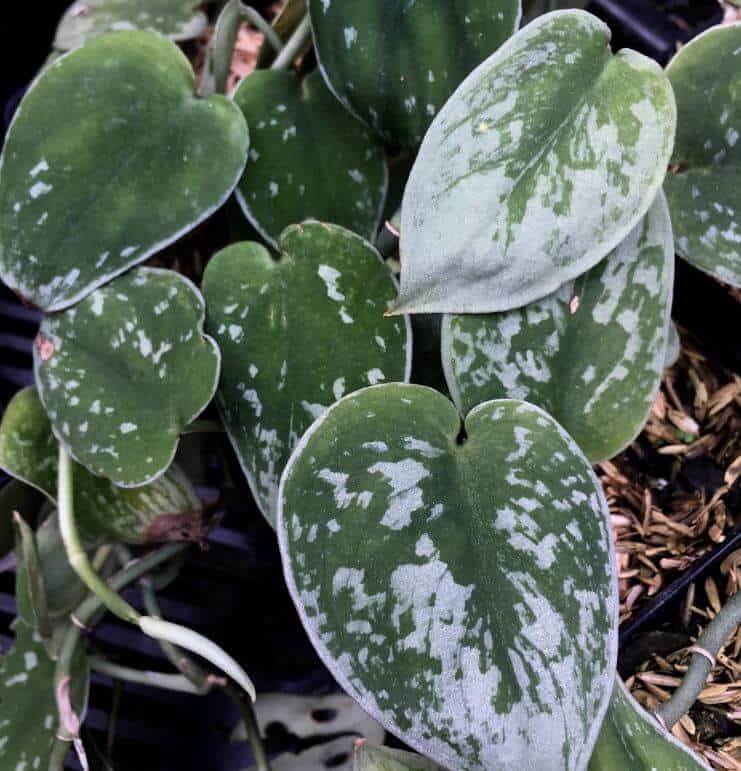
The Scindapsus pictus ‘Silvery Ann’ likes bright, generous, indirect sunlight. If you have selected this plant for its unique variegation, medium to low lighting may sabotage this. Plants subjected to lower light develop more chlorophyll, so variegation suffers.
Ideally, the Silvery Ann needs to be positioned approximately two to three feet from a window or if nearer, the window should have a sheer curtain. This will protect your plant’s foliage from scorching. If you reside in USDA hardiness zones 9 through 11 and plan on cultivating a Silvery Ann outdoors, choose a position with shade from other vegetation.
Water
This houseplant has minimal watering needs and will tolerate a bit of drought. Overwatering will potentially lead to root rot which can be fatal. Err on the side of underwatering. Plan on watering once weekly. Winter watering can be reduced, while summer watering, depending on the heat may need to be slightly increased.
Humidity
The Silvery Ann is tolerant of an ample range of humidity levels, although it prefers humidity ranging from 50% to 70% if possible. Space humidifiers, pebble trays, and occasional misting will aid your plant in achieving optimal growth.
Temperature
As a tropical, your Silvery Ann Pothos prefers temperatures in the range of 60° to 75° F. It is not tolerant of cold or cooler temps. Temps below 50°F can damage the plant.
Feeding
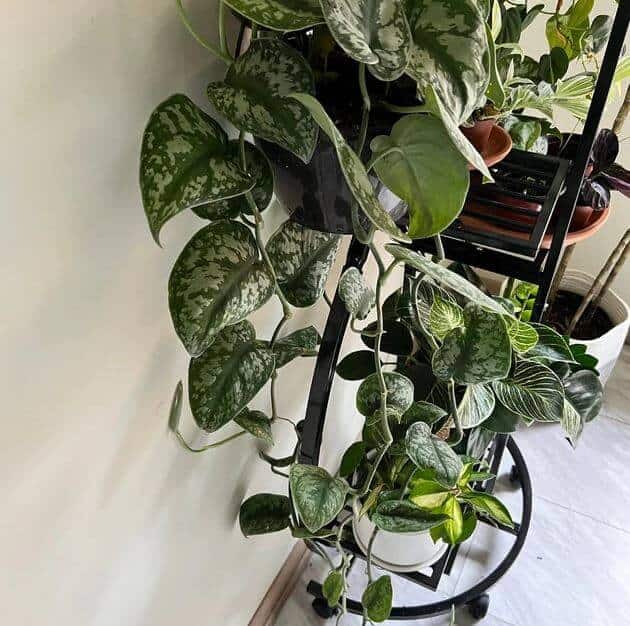
The Scindapsus pictus ‘Silvery Ann’ does not feed heavily but an occasional nutrient boost through fertilization will aid growth. Use a quality all-purpose houseplant fertilizer with an NPK of 10-10-10 monthly during the growing season. Avoid overfertilization to prevent salt buildup in the soil.
Pruning
When cultivated indoors as a houseplant, the Scindapsus pictus ‘Silvery Ann’ rarely grows higher than three to four feet. If cultivated as a trailing plant in a hanging basket, it may spread more. The amount of pruning necessary will depend on how you are growing your plant. Occasional trimming will encourage new growth and keep your plant healthy and vibrant. Always remove dead, dying, yellowing, or damaged foliage, especially found near the plant’s base.
Repotting a Silvery Ann Pothos
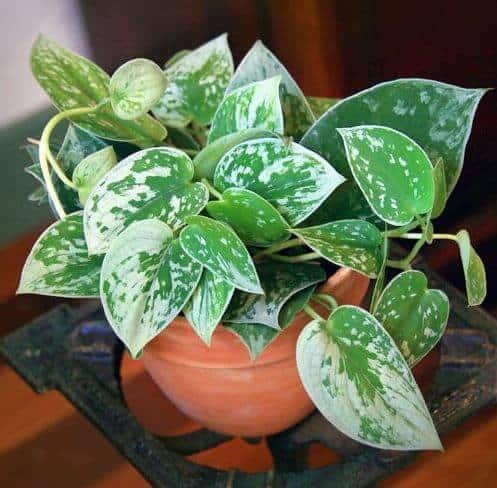
The Silvery Ann Pothos will need to be repotted every second to third year. It may need to be repot sooner if you notice roots peeking from the drainage holes or soil surface. When repotting, use a pot that is twice the size of the current container to encourage growth.
Pothos Silvery Ann Propagation
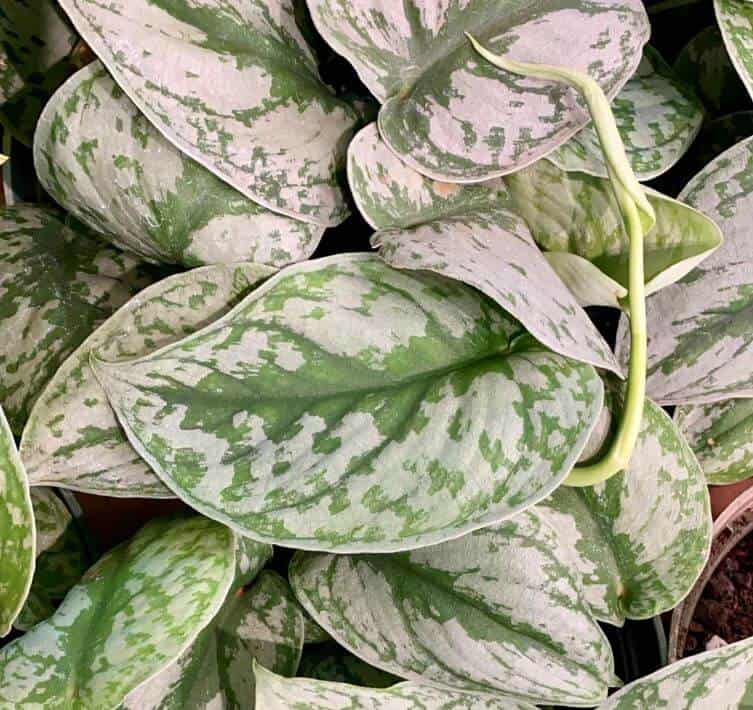
This aroid plant develops roots easily and relatively quickly. You can opt to use root division or stem cuttings to create new plants.
When repotting, separate the root system into two or more sections and plant them in individual pots. Water your new plants thoroughly and position them in a location with generous light.
To propagate using stem cuttings, trim a stem section with at least one node and three leaves. Place the cutting in a transparent jar of water or directly into the fresh soil mix. If cultivated in water, once the roots develop to approximately two inches in length, you can transplant your cutting into the soil. Water thoroughly to ease the transition.
Silvery Ann Pothos Problems
One benefit of cultivating this houseplant is that they are not overly susceptible to pest infestations. Still, it’s wise to examine your plant every so often for signs of spider mites, mealybugs, and scales as they will suck the sap from the plant damaging it. These pests can be eliminated through the application of insecticidal soap, citronella, or neem oil.
Overwatering can lead to fatal root rot as well as create the perfect environment for both bacterial and fungal infections. The yellowing of foliage can also be indicative of excess moisture. Scale back your watering schedule.
A lack of variegation points to inadequate light, while stunted growth may indicate a nutrient deficiency and require fertilization.
Silvery Ann Pothos Toxicity
The Pothos Silvery Ann contains calcium oxalate crystals making it toxic to both humans and family pets. Ingestion of plant parts can result in vomiting, drooling, nausea, swelling, diarrhea, irritation, and breathing difficulty. Find a spot that positions your plant out of reach. If you suspect ingestion contact medical or veterinary personnel immediately.
The Silvery Ann vs. Satin Pothos
Both of these plants are varieties of the Scindapsus pictus. The distinguishing characteristic between a Silvery Ann and a Satin pothos is the foliage. The Silvery Ann will feature greater variegation that is more disorderly in its patterning. Its foliage tissue will contain less chlorophyll. A Satin pothos will have variegation that appears more regular in design.
The Silver Satin pothos also boasts larger-sized foliage and a faster growth habit than the Silvery Ann pothos. The Satin also may require more frequent watering. Aside from these differences, they have similar care requirements.

